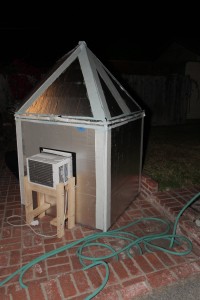Please feel free to comment on this blog post if you have questions.
This is an well-insulated, air-conditioned, and dust-storm resistant yurt for use in hot, dry, desert environments. It is constructed out of 7 4’x8’x1″ R-Max panels. Rather than using tape, I used rubber cement and “Tuff” waterproof drop cloth cut in ~10″ strips to create my own “extra durable” water/dust/sunproof tape. Interfaces in the roof and between the roof and side walls include 8″ flaps (one top and bottom) that are rolled together to provide a good seal. Top and bottom edges, as well as the door and A/C cutouts, are edged with corner bead (think drywall corners) held together with 1″ 10-24 machine screws. I’ve sprayed the yurt with a borax and boric acid solution to provide a degree of fire retardant given the flammability of the materials involved.
On-playa assembly requires only a few dozen zip ties and can be accomplished by one person in less than an hour if the air is still. Simply “zip up” the yurt (12′) and the loose ends of the vertical walls (just one loose end, 4′). Then, place the roof on the bottom walls and zip-tie it into place. Improve dust resistance by placing the yurt on a large tarp and using bungee cords to attach the tarp to some of the loops created by the zip ties. Finally, tie down your yurt with rope and rebar to avoid losing it in a wind storm. Creating a “halo” of rope around the roof makes it easier to tie down.
The entire yurt folds into a 4’x4’x16″ cube and weighs under 100 lbs. It fits nicely on a roof-mount bike rack. While this design is more costly than the basic tape-based design, it is more durable and costs less than a dollar per use. It would be free if a reusable alternative to the zip ties were identified.
In retrospect, I think the most significant design improvement is the use of zip-ties, corner beads, and fabric to provide inexpensive reuse, rapid dust-tolerant assembly, and greater durability. I am not sure the fabric “tape” I used was helpful, and this was by far the messiest and most time-consuming aspect of the yurt’s assembly.
- Inside the yurt
- Side view
- With air conditioner
- Zip ties and corner beads





Leave A Comment